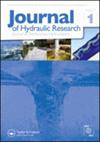波纹管道中多点水柱分离瞬态流的空化演化及流场特性
IF 1.7
3区 工程技术
Q3 ENGINEERING, CIVIL
引用次数: 1
摘要
采用高精度压力传感器、高速摄影技术和粒子图像测速技术,对三种典型试验用例在快速阀门关闭条件下波动管道内水流诱导多点空化瞬态流动进行了实验研究。当初始速度较低时,阀门下游监测点(PT1)的瞬态压力迅速降低至空化压力,并在其附近波动。分散的泡状空化群前缘速度随着空化的发生先增大,然后由于粘滞力和水流惯量的减小而加速并达到极值后减小为零,最后水流反向向上游流动,即前缘在阀后加速坍缩。同时,由于压缩波的返回,瞬态压力急剧上升至最大值81.86 m,然后由于压力波的切换,再次急剧下降至空化。第二次空化强度较弱,呈雾状,最后逐渐减小,循环周期约为0.38 s。波动管道峰值监测点(PT2)的瞬态压力除了在空化压力附近包括第一次和第二次空化的波动外,也保持在大泡发生时刻对应的空化压力。其最大压力为72.16 m,在不同的空化阶段,相应的空化形态为气泡大小不同。对于中初速度,相应的空化典型模式为PT2处具有自由表面的大空腔,相应的最高压力在PT1处为102.36 m,在PT2处为84.81 m。基于破碎波理论和水力动力学理论,分析了空腔的演化过程,包括气泡合并、形态变形、运动和崩塌。当初始速度较高时,在阀门下游和波动管道峰值处均出现较大空腔,因此在PT1和PT2处,较大空腔崩塌导致的最大压力分别为140.56 m和127.98 m。特别是,水柱完全分离,阀门下游出现透明大空腔。本文章由计算机程序翻译,如有差异,请以英文原文为准。
Cavitation evolution and flow field characteristics of transient flows with multi-point water-column separations in undulating pipeline
Transient flows with water-flow-induced multi-point cavitation inside an undulating pipeline are investigated experimentally under conditions of fast valve closure for three typical test cases by using high-precision pressure transducers, high-speed photography and particle image velocimetry (PIV) techniques. For low initial velocity condition, the transient pressure at the monitoring point (PT1) downstream the valve quickly decreases to the cavitation pressure and fluctuates near it. The leading-edge velocity of the dispersed bubble-like cavitation group first increases with its occurrence and then accelerates and reaches an extreme value before decreasing to zero due to the viscous force and the decrease of water flow inertia, and finally the water flows upstream in reverse, i.e. the leading-edge accelerates and collapses behind the valve. At the same time, the transient pressure rises sharply to maximum 81.86 m due to the return of the compression wave and then decreases sharply to cavitation again because of the switch of the pressure waves. Then, the second cavitation intensity is weak and the corresponding pattern is fog-like, and finally decreases gradually with a cyclic period of about 0.38 s. The transient pressure at the monitoring point (PT2) at the peak of the undulating pipeline also maintains at the cavitation pressure corresponding to the big bubble occurrence moment in addition to its fluctuation near the cavitation pressure including first and second cavitation. Its maximum pressure is 72.16 m and the corresponding cavitation pattern is small and bigger bubbles at different cavitation stages. For middle initial velocity, the typical pattern of the corresponding cavitation is the large cavity with free surface at PT2, the corresponding higher maximum pressures are 102.36 m at PT1 and 84.81 m at PT2. The evolution process of the cavity including bubble mergence, morphological deformation, motion and collapse is analysed based on the broken wave and hydraulic dynamic theories. For high initial velocity, larger cavities occur both downstream the valve and at the peak point of undulating pipeline, and thus the corresponding higher maximum pressures due to larger cavity collapse are 140.56 m at PT1 and 127.98 m at PT2. In particular, complete water column separation with transparent large cavity occur downstream the valve.
求助全文
通过发布文献求助,成功后即可免费获取论文全文。
去求助
来源期刊

Journal of Hydraulic Research
工程技术-工程:土木
CiteScore
4.90
自引率
4.30%
发文量
55
审稿时长
6.6 months
期刊介绍:
The Journal of Hydraulic Research (JHR) is the flagship journal of the International Association for Hydro-Environment Engineering and Research (IAHR). It publishes research papers in theoretical, experimental and computational hydraulics and fluid mechanics, particularly relating to rivers, lakes, estuaries, coasts, constructed waterways, and some internal flows such as pipe flows. To reflect current tendencies in water research, outcomes of interdisciplinary hydro-environment studies with a strong fluid mechanical component are especially invited. Although the preference is given to the fundamental issues, the papers focusing on important unconventional or emerging applications of broad interest are also welcome.
 求助内容:
求助内容: 应助结果提醒方式:
应助结果提醒方式:


